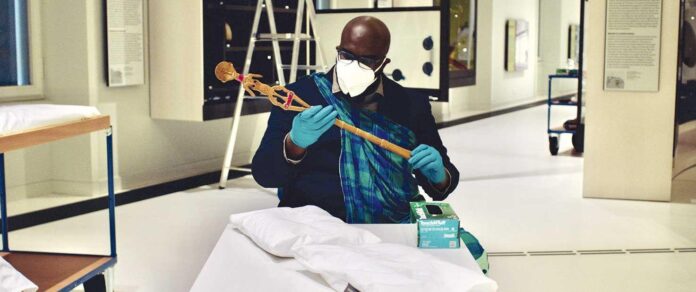An exhibition at the Mauritshuis in The Hague aims to demonstrate that looted objects can continue to have a life in Western museums even after they have been repatriated. In Loot—Ten Stories, the guest curators and film-makers Eline Jongsma and Kel O’Neill have investigated ten objects looted at various points in history—by Napoleon in Berlin, by Nazi Germany and during the Dutch colonial era—using film and virtual reality to bring to life the stories behind them.
“Governments and museums have to reckon with the fact that they probably have to return a lot of things and it’s only fair,” Jongsma says. “Some are a little slower than others but there’s no way back. It’s prompting all these questions. Are the originals the only things that have value?”
With the help of three virtual reality installations and three video installations, the curators suggest that such objects can continue to tell their stories beyond restitution.
“A lot of what this show is about is this moment that we’re in when restitution claims are being made and at the same time digital technology is accelerating to the point where the creation of a digital double or a photogrammetry 3D model is transforming how people show objects in museums,” O’Neill says.
For instance, the looted 18th-century Cannon of Kandy, which is being returned to Sri Lanka by Amsterdam’s Rijksmuseum, will not be in the exhibition physically but as a digital double, created with the help of scanning experts and 3,000 photographs. This “object” is now carried on six hard drives (two of which will also be restituted).
With the help of Unreal Engine, the software company behind computer games such as Fortnite, the curators have also created scenes reimagining how objects were lost, such as the sculpture of a horse’s head looted from the Brandenburg Gate when Napoleon’s troops entered Berlin in 1806, or a Balinese kris dagger stolen when Dutch soldiers invaded Bali in 1849. Visitors will be able to walk around these virtual, reimagined worlds, which O’Neill describes as time machines. “We have come to believe these things are museum objects because they are in museums,” he says. “But they have a rich history before they found their way into the depots, and they may have a richer history afterwards.”
The exhibition will also include evidence from Indigenous experts, who are not typically consulted by Western museums. One video will show Onias Landveld, a poet of Surinamese origin, examining a carved walking stick stolen in Suriname around 1900 and now in Berlin’s Ethnological Museum. “Why is it still here?” he asks.
Museums will have to think creatively about telling these stories. “Let’s say everybody gets their stuff back, then what do you do?” O’Neill asks. “To us, these new interventions—digital copies, storytelling around objects, virtual reality—make a lot more sense. You can start to bring in multiple voices and maybe figure out a way to make a more contemporary, more complete experience that reflects the lives of a new generation of museum goers.”
The exhibition is a partnership between the Mauritshuis, three Berlin museums—the Ethnological Museum, the Stadtmuseum and the Gipsformerei—and the Museum of Fine Arts in Rennes. It will travel to Berlin’s Humboldt Forum next spring.
• Loot—Ten Stories: Jongsma + O’Neill x Mauritshuis, Mauritshuis, The Hague, 14 September-7 January 2024

























